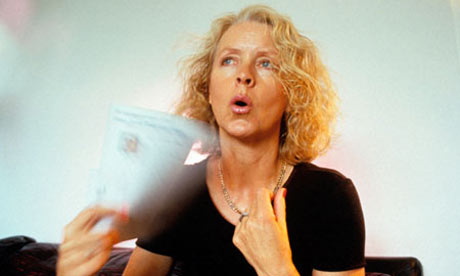
The Victorians thought it drove women mad, while the early Greeks believed it could be cured by applying leeches, but the menopause is a natural part of every woman's life cycle. Even so, each woman's experience will be different. Some may cruise through it with few problems; others have symptoms so dire as to make life intolerable. Some may feel liberated by stopping having periods; others may be sad that they can no longer get pregnant. The actor Julie Walters described the menopause as an uncomfortable rite of passage. But how you cope may well depend on what else is going on in your life, and how much stress you are under.
The menopause occurs when your ovaries stop making oestrogen and progesterone, the two key hormones that control the menstrual cycle. This happens gradually, over several years, with many women seeing the first signs – such as periods going haywire – in their 40s. The average age at which a woman has her last period is 51, although smokers and thinner women tend to reach the menopause earlier.
Menopausal symptoms can be demoralising. Hot flushes, night sweats, a dry vagina (which can lead to inflammation and make sex uncomfortable), and urinary problems are directly caused by the decline in oestrogen levels. But many women report myriad other symptoms, including weight gain, loss of libido, low energy, mood swings and forgetfulness. Researchers aren't certain if these are also caused by hormone changes, or linked to more general health and lifestyle factors, and the emotional upheavals that are common at this time of life – from empty nest syndrome to caring for elderly parents.
Until recently, hormone replacement therapy (HRT) was the standard treatment for hot flushes, vaginal dryness and increasing general wellbeing; but we now know that it increases the risk of breast cancer, blood clots and strokes. For most women, the increased risk is small: for every 1,000 women in their 50s using HRT for five years, there will be six extra cases of these conditions. It's worth talking to your doctor about your individual risk, which will also depend on your overall health and family history. If you opt for HRT, aim to take it at the lowest dose for the shortest possible time and review annually with your GP. There are a number of ways you can take HRT, including topical creams and tablets you put in your vagina. These work well if vaginal dryness is your main problem, and only a small amount will be absorbed into the bloodstream, making the risks of side effects lower.
The synthetic hormone tibolone also helps with hot flushes and vaginal dryness and can increase your sex drive; but as with HRT, it increases the risk of stroke (more so than HRT) and breast cancer (less so). Testosterone (which women make in small amounts, and which may decline at menopause) is occasionally used for loss of sex drive too, but it may cause acne or an increase in body hair, and it reduces blood levels of "good" cholesterol.
Clonidine, a drug normally prescribed for high blood pressure, is sometimes used to treat hot flushes. It works for some women but can have side effects such as dry mouth and drowsiness. Some antidepressants may also help with hot flushes. And for women under 50 with menopausal symptoms, the contraceptive pill can provide both relief and birth control.
If you're keener on "natural" remedies, there are a multitude to choose from, including agnus castus and dong quai, although there is little evidence as to whether or not they work. There are also concerns about safety, quality control and potential interactions with conventional medicines, so tell your doctor about any alternative treatments you take.
Some women swear by black cohosh, a traditional native American herbal remedy which is said to have oestrogenic effects, but studies so far have shown conflicting results. And the herb is linked to possible liver problems, so see your doctor if you get symptoms such as loss of appetite, yellowing skin/eyes or dark urine. St John's wort, meanwhile, can help with mild depression.
There's been a lot of scientific interest in phytooestrogens – chemicals from plants that are thought to have oestrogen-like effects. These are especially high in soy-based foods such as tofu and miso, but also come as supplements. One big review, published in 2007, found no good evidence that the supplements alleviated hot flushes, and there is concern that they could increase the risk of oestrogen-related cancers, although there is no proven link.
Don't dismiss self-help measures. Bioadhesive moisturisers and gel lubricants can help with vaginal problems. And keeping a fan in the bedroom, sleeping in pure cotton sheets and dressing in layers that can be easily removed will help with hot flushes, as will avoiding triggers such as spicy food and coffee. If you're lacking in energy and generally low, look after yourself: eat well, exercise, learn a stress reduction technique such as yoga – and make time for things you enjoy.
As the body adjusts to hormone changes, most symptoms – apart from vaginal dryness – disappear after about four years. But it's crucial to keep taking care of your health. The decline in oestrogen levels leaves many women more susceptible to bone loss and heart disease, although the risks can be modified by healthy living and, if necessary, medication. Meanwhile, if the hot flushes get you down, try referring to them instead – as some women do – as "power surges".

